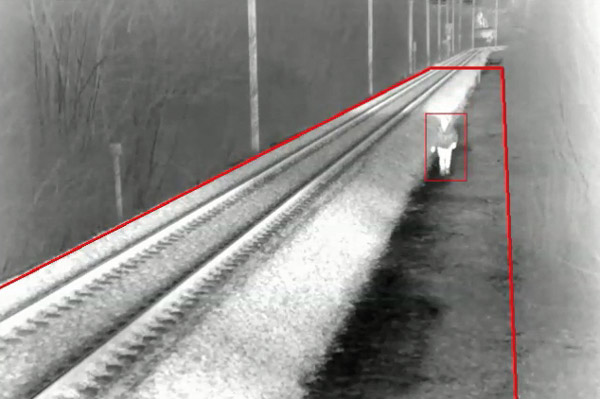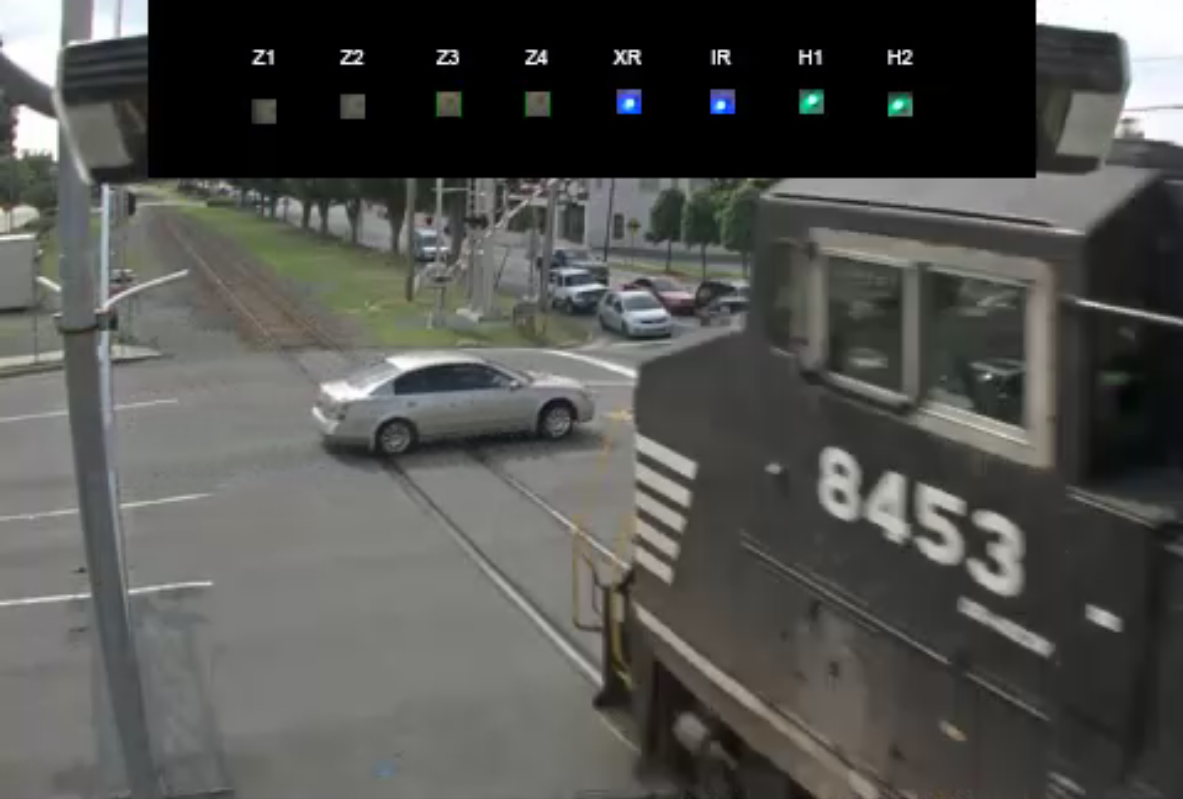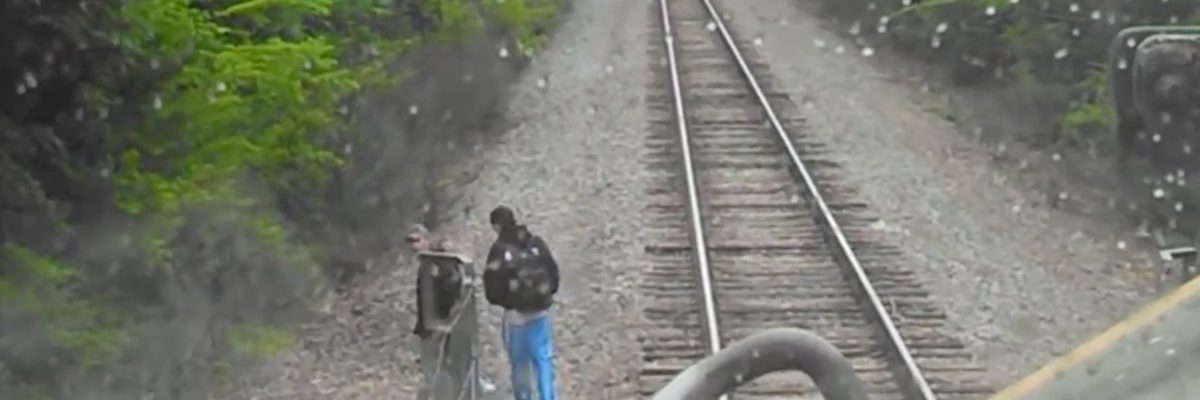NCDOT and ITRE: Rail Trespass Project
Explanation of project:

Pole-mounted thermal camera for static setup, with detection and flagging zones [http://www.flir.com/uploadedImages/Traffic/Applications/trackside-monitoring-2.jpg]
The goal of the NCDOT Rail Corridor Trespass Severity Assessment is to count the number of incidents of trespassing on the railroad right of way and gain an understanding of human behaviors in the North Carolina rail environment. Armed with this information, our education, engineering and enforcement efforts can be rationally focused to prevent loss of life which often occurs during railroad trespassing. The use of video to record the incidents of trespassing is not intended to identify the trespasser, but to allow an accurate count and show the locations (unauthorized crossings, bridges, pathways, etc.) where the trespassing occurs. The act of trespassing is a Class 3 misdemeanor, the lowest classification of misdemeanor under the North Carolina criminal statutes.
In this day of smart phones and closed circuit cameras, any person in a public or open space should reasonably assume they are subject to video recording. A person does not have the same right to privacy in a public or open space as the person does in their home or the curtilage of their home.
The video footage for this research project will be not be archived or stored by NCDOT. NCDOT reserves the right to preserve select video footage for use in educational or engineering efforts if certain circumstances exist. Those circumstances, on a case by case basis, would meet stringent criteria. Use of the preserved video would be reserved for promotion of better understandings of trespass behavior for officials of railroad companies and rail communities to improve trespassing deterrents. Those select videos that meet the criteria would be displayed in a manner that would not permit the viewer to identify a human or the date, time or place of the trespassing activity.
Protection for subjects:
Certificate of Confidentiality (COC) from National Institutes of Health (NIH). An Institutional Review Board (IRB) has approved of the study methodologies through North Carolina State University at Raleigh (NCSU) has approved of the studies’ methodologies.
IRB – 11636
FWA – 00003429
COC ID: CC-GM-17-011
COC Contact Info:
Erica Brown, Ph.D.
National Institute of General Medical Sciences
Division of Extramural Activities
erica.brown@nih.gov
Natcher Center, Room 2AN24F
45 Center Drive
Bathesda, MD 2089
ITRE Contact Info:
Christopher Cunningham
Program Manager
cmcunnin@ncsu.edu

Near collision between freight engine and vehicle trespassing as gates descend
Statement:
By viewing this website, you are consenting to being recorded within the scope of these projects.
To help us protect your privacy, we have obtained a Certificate of Confidentiality from the National Institutes of Health. The researchers can use this Certificate to legally refuse to disclose information that may identify you in any federal, state, or local civil, criminal, administrative, legislative, or other proceedings, for example, if there is a court subpoena. The researchers will use the Certificate to resist any demands for information that would identify you, except as explained below.
The Certificate cannot be used to resist a demand for information from personnel of the United States federal or state government agency sponsoring the project and that will be used for auditing or program evaluation of agency funded projects or for information that must be disclosed in order to meet the requirements of the Federal Railroad Administration (FRA). You should understand that a Certificate of Confidentiality does not prevent you or a member of your family from voluntarily releasing information about yourself or your involvement in this research. If an insurer, medical care provider, media representative, or other person obtains your written consent to receive research information, then the researchers will not use the Certificate to withhold that information.
The Certificate of Confidentiality will not be used to prevent disclosure to state or local authorities of any of the following:
| Class Felony | Charge |
|---|---|
| A | G.S. 14-17 Murder in the 1st degree. |
| B1 | G.S. 14-27.2 1st degree rape. |
| B1 | G.S. 14-27.4 1st degree sexual offense. |
| B1 | G.S. 14-27.7 A (a) Statutory rape or sexual offense of person who is 13, 14, or 15 years old (Defendant is at least six years older than victim). |
| B2 | G.S. 14-17 Murder in the 2nd degree. |
| C | G.S. 14-27.3 2nd degree rape. |
| C | G.S. 14-27.5 2nd degree sexual offense. |
| C | G.S. 14-27.7A (b) Statutory rape or sexual offense of person who is 13, 14, or 15 years old (Defendant is more than four but less than six years older than victim). |
| C | G.S. 14-32(a) Assault with deadly weapon with intent to kill inflicting serious injury. |
| C | G.S. 14-39 Kidnapping in the 1st degree. |
| D | G.S. 14-18 Voluntary manslaughter. |
| D | G.S. 14-87 Robbery with firearms or other dangerous weapons. |
| D | G.S. 14-88 Train robbery. |
| E | G.S. 14-30.1 Malicious throwing of corrosive acid or alkali. |
| E | G.S. 14-31 Maliciously assaulting in a secret manner. |
| E | G.S. 14-32(b) Assault with deadly weapon inflicting serious injury. |
| E | G.S. 14-32(c) Assault with deadly weapon with intent to kill. |
| E | G.S. 14-34.5 Assault with a firearm on a law enforcement officer. |
| E | G.S. 14-39 Kidnapping in the 2nd degree. |
| E | G.S. 14-318.4(a) Child abuse inflicting serious injury. |
| E | G.S. 14-318.4(a1) Child abuse - prostitution. |
| E | G.S. 14-318.4(a2) Child abuse - sexual act. |
| F | G.S. 14-16.6(b) Assault with a deadly weapon on executive, legislative, or court officer. |
| F | G.S. 14-16.6(c) Assault inflicting serious bodily injury on executive, legislative, or court officer. |
| F | G.S. 14-18 Involuntary manslaughter. |
| F | G.S. 14-32.1(e) Aggravated assault/assault and battery on handicapped person. |
| F | G.S. 14-32.2(b)(3) Patient abuse and neglect, conduct proximately causes serious bodily injury. |
| F | G.S. 14-32.3(a) Domestic abuse, neglect, and exploitation of disabled or elder adults (abuse results in serious injury). |
| F | G.S. 14-32.4 Assault inflicting serious bodily injury. (Effective 1/1/97) |
| F | G.S. 14-34.2 Assault with a firearm or other deadly weapon upon governmental officers or employees, company police officers, or campus police officers. |
| F | G.S. 14-34.7 Assault inflicting serious injury on a law enforcement, etc., officer. |
| G | G.S. 14-58 Arson in the 2nd degree. |
| I | G.S. 14-56 Breaking or entering into/out of railroad cars |
| I | G.S. 14-280 Shooting or throwing at trains or passengers. |
